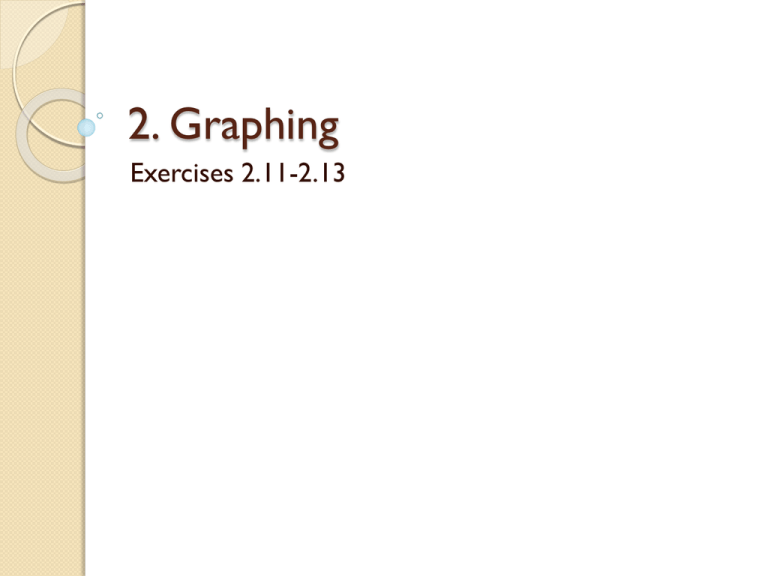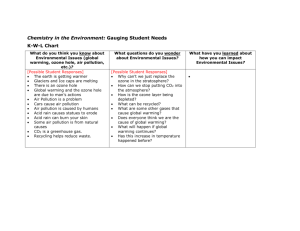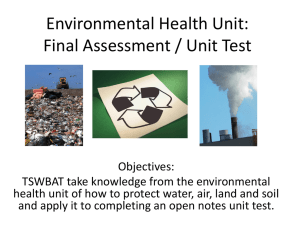2. Graphing Exercises 2.11-2.13
advertisement

2. Graphing Exercises 2.11-2.13 Exercise 2.11(a) Graph 1. What type of graph is this? combined column/line 2. What information is the graph providing? variation in rainfall patterns across the year in Newcastle 2. Can you see any problems with the graph? gridlines for the number of raindays are pointless (better for the avge rainfall) scale for number of raindays compresses the line, but 0-30 makes sense if this graph type used generally 4&6. March/November 5&7. Which month has the highest/lowest average rainfall? What is the rainfall for those months? 120/70 mm Exercise 2.11(a) Graph 8&10. Which month has the highest/lowest average number of raindays? March and May/September 9&11. What is the number of days for those months? 12/10 Exercise 2.11(b) Graph 1. Example of a region showing an increase of 5 hot days/10 years. NW corner of NSW 2. Example of a region showing an increase of 2 hot days/10 years. several, including Gold Coast 2. Example of a region showing a decrease in hot days. Nthn WA 4. FIVE important pieces of general information to be gained from this graph. most places getting more hot days eastern Australia more so than WA trend isn’t consistent only already hot regions showing fewer hot days Tasmania not showing extra hot days Exercise 2.11(c) Graph 1. Where in Australia has the greatest amount of thunder? Nthn Territory near Darwin 2. Where in Australia has the least amount of thunder? E coast Tasmania 2. Is there a general trend in thunder behaviour from north to south? What is it? Yes it gets less 4. Give TWO examples of regions that are exceptions to the basic trend? NW of Kalgoorlie N of Ncle Exercise 2.11(d) Graph 1. What type of graph is this? scatter 2. Which axis belongs to windspeed? Air temperature? wind - vertical temp - horizontal 2. What is the (i) lowest and (ii) highest windspeed recorded? 0 & 59 4. What is the (i) lowest and (ii) highest temperature recorded? -12 & -0.5 5. What conclusions can you draw from the graph? temperatures in this region mostly 0 to -4 in this range, windspeeds can be anything at lowest temps, windspeeds are less Exercise 2.12 Exercise 2.12 Graph (a) Given the ozone layer is a zone of the atmosphere with relatively high concentrations of ozone, what is its altitude range? 16-24,000 m (b) Given the ozone hole is a loss in concentration in the layer, in which months does it occur? Days 250-350 September-December (c) You are required to draw a graph showing the change in ozone concentration in the ozone layer across the year. How will you do it? draw a line across @ 20000 m at each 10 day marker, record the colour as a ozone level use the middle of the range, eg for 100-120, use 110 Q1. How does air pollution in Sydney vary throughout the year? What summary statistics would you need to help you answer this question? ◦ time series graph (values vs day) ◦ monthly/season averages/maxima ◦ L/M/H frequencies monthly Q2. How does air pollution in Sydney vary geographically? What summary statistics would you need to help you answer this question? ◦ monthly averages/maxima for each region ◦ L/M/H monthly readings for each region ◦ how often one region is higher than the others 1 - Time Series of Daily Maxima (All regions) Q1 – yes, Q2 - no 2 – L/M/H Readings of Daily Maxima (All Regions) Q1 – yes, Q2 - no 3 - Monthly Averages By Region Q1 – yes, Q2 - yes 4 – L/M/H Readings Monthly By Region Q1 yes, Q2 yes 5 - Daily Comparison of Readings Between Regions Q1 no, Q2 yes 6 - Correlation of Monthly Averages & SDs Q1 – no, Q2 - no Conclusions Q1 - time highest readings are in summer particularly bad in SW in summer April-July least pollution generally Q2 - geographically NW & SW worse than CE except in winter CE more consistent SW shows great variation across year What does Q6 tell you? as the pollution gets worse (summer), the day-to-day variability gets greater






